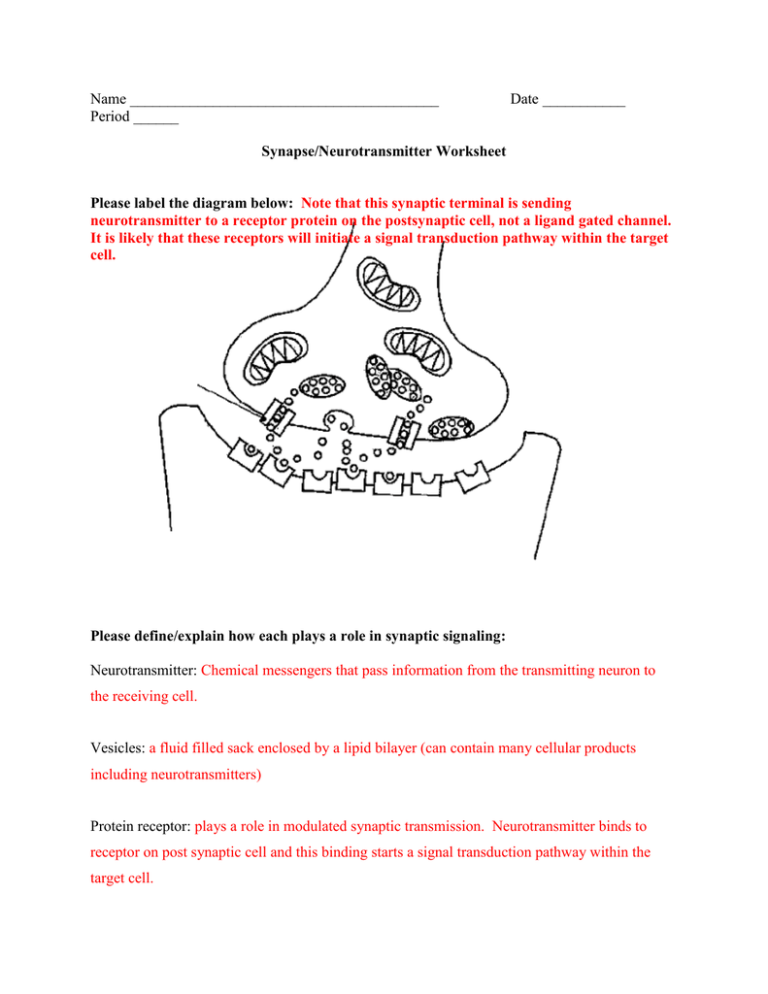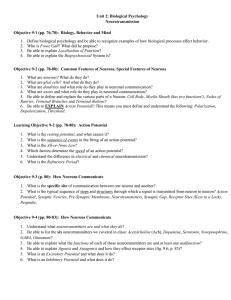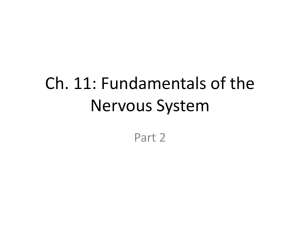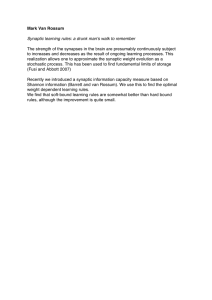Name _________________________________________ ... Period ______ Synapse/Neurotransmitter Worksheet
advertisement

Name _________________________________________ Period ______ Date ___________ Synapse/Neurotransmitter Worksheet Please label the diagram below: Note that this synaptic terminal is sending neurotransmitter to a receptor protein on the postsynaptic cell, not a ligand gated channel. It is likely that these receptors will initiate a signal transduction pathway within the target cell. Please define/explain how each plays a role in synaptic signaling: Neurotransmitter: Chemical messengers that pass information from the transmitting neuron to the receiving cell. Vesicles: a fluid filled sack enclosed by a lipid bilayer (can contain many cellular products including neurotransmitters) Protein receptor: plays a role in modulated synaptic transmission. Neurotransmitter binds to receptor on post synaptic cell and this binding starts a signal transduction pathway within the target cell. Axon Terminal (pre synaptic receptor): synaptic terminal/synaptic knob or button that receives action potential from axon that precedes it and releases neurotransmitters. Dendrite (post synaptic receptor): part of a post synaptic cell that receives the neurotransmitter released from the neuron upstream. Axon: portion of neuron that propagates an action potential located between the cell body and the synaptic terminal. Ligand-gated ion channels: binding of a neurotransmitter to these channels as a ligand opens the channel and allows specific ions to flow across the post synaptic membrane. Neurotransmitters: 1. Neurotransmitters are the chemical __messengers__________ that neurons use to communicate with other cells____________. 2. Neurotransmitters can be : • _Excitatory___________ (cause something to happen) • _Inhibitory___________ (stopping a process) 3. When neurotransmitters are released into the synaptic gap, they bind to __receptors__________ which cause the next neuron to create an action potential or signal transduction pathway starting the whole process over again. 4. Neurotransmitters: • Dopamine- present in feelings of __euphoria____ or feeling high. Also activates the ____________ ____________ in the brain. • Serotonin- responsible for __sleep__________, __mood__________, ___attention_________. • Endorphins- responsible for __block pain________ __feelings of pleasure__________. Acetylcholine – responsible for ______excitatory transmitter that binds to ligand gated channels on muscle cell receptor proteins.__ ________________________. Epinephrine and norepinephrine – responsible for __fight or flight response act as neurotransmitters and hormones.____ ______. 5. The Binding Process: When the sending neuron releases Nt’s across the synaptic gap, the Nt’s fit into receptors like a key fits in a lock. 6. Stopping the Process: When the next neuron creates an action potential (after enough Nt’s have attached to receptors) the Nt’s are stopped in one of three ways. • Diffusion: simple diffusion causes neurotransmitters to be removed from the synaptic cleft • Reuptake: neurotransmitters can be actively transported into the presynaptic neuron to be repackaged into synaptic vesicles (from whence they came), or transported to glia to be metabolized as fuel. • Enzymes: through hydrolysis enzymes break down neurotransmitters and clear them from the synapse





